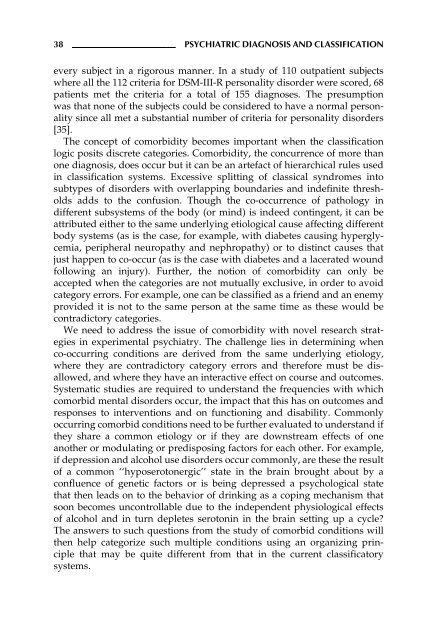Psychiatric Diagnosis and Classification - ResearchGate
Psychiatric Diagnosis and Classification - ResearchGate
Psychiatric Diagnosis and Classification - ResearchGate
You also want an ePaper? Increase the reach of your titles
YUMPU automatically turns print PDFs into web optimized ePapers that Google loves.
38 PSYCHIATRIC DIAGNOSIS AND CLASSIFICATION<br />
everysubject in a rigorous manner. In a studyof 110 outpatient subjects<br />
where all the 112 criteria for DSM-III-R personalitydisorder were scored, 68<br />
patients met the criteria for a total of 155 diagnoses. The presumption<br />
was that none of the subjects could be considered to have a normal personalitysince<br />
all met a substantial number of criteria for personalitydisorders<br />
[35].<br />
The concept of comorbiditybecomes important when the classification<br />
logic posits discrete categories. Comorbidity, the concurrence of more than<br />
one diagnosis, does occur but it can be an artefact of hierarchical rules used<br />
in classification systems. Excessive splitting of classical syndromes into<br />
subtypes of disorders with overlapping boundaries <strong>and</strong> indefinite thresholds<br />
adds to the confusion. Though the co-occurrence of pathologyin<br />
different subsystems of the body or mind) is indeed contingent, it can be<br />
attributed either to the same underlying etiological cause affecting different<br />
body systems as is the case, for example, with diabetes causing hyperglycemia,<br />
peripheral neuropathy<strong>and</strong> nephropathy) or to distinct causes that<br />
just happen to co-occur as is the case with diabetes <strong>and</strong> a lacerated wound<br />
following an injury). Further, the notion of comorbidity can only be<br />
accepted when the categories are not mutuallyexclusive, in order to avoid<br />
categoryerrors. For example, one can be classified as a friend <strong>and</strong> an enemy<br />
provided it is not to the same person at the same time as these would be<br />
contradictorycategories.<br />
We need to address the issue of comorbiditywith novel research strategies<br />
in experimental psychiatry. The challenge lies in determining when<br />
co-occurring conditions are derived from the same underlying etiology,<br />
where theyare contradictorycategoryerrors <strong>and</strong> therefore must be disallowed,<br />
<strong>and</strong> where theyhave an interactive effect on course <strong>and</strong> outcomes.<br />
Systematic studies are required to underst<strong>and</strong> the frequencies with which<br />
comorbid mental disorders occur, the impact that this has on outcomes <strong>and</strong><br />
responses to interventions <strong>and</strong> on functioning <strong>and</strong> disability. Commonly<br />
occurring comorbid conditions need to be further evaluated to underst<strong>and</strong> if<br />
theyshare a common etiologyor if theyare downstream effects of one<br />
another or modulating or predisposing factors for each other. For example,<br />
if depression <strong>and</strong> alcohol use disorders occur commonly, are these the result<br />
of a common ``hyposerotonergic'' state in the brain brought about by a<br />
confluence of genetic factors or is being depressed a psychological state<br />
that then leads on to the behavior of drinking as a coping mechanism that<br />
soon becomes uncontrollable due to the independent physiological effects<br />
of alcohol <strong>and</strong> in turn depletes serotonin in the brain setting up a cycle<br />
The answers to such questions from the studyof comorbid conditions will<br />
then help categorize such multiple conditions using an organizing principle<br />
that maybe quite different from that in the current classificatory<br />
systems.

















